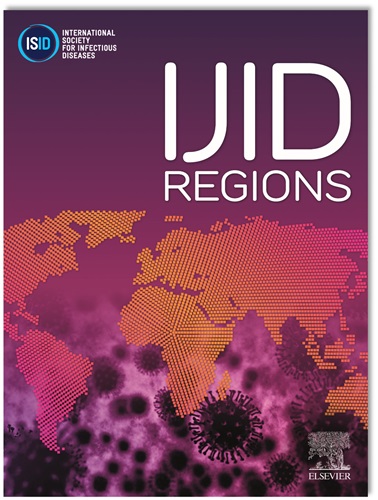Incidence of acute respiratory infections and their associated pathogen distribution among residents in Shanghai, China: preliminary results from community-based surveillance in the 2023-2024 influenza season
IF 4.8
2区 医学
Q1 INFECTIOUS DISEASES
引用次数: 0
Abstract
Objectives
This study aimed to assess the risk of acute respiratory infections across distinct age demographics, analyze factors associated with infection, and characterize respiratory pathogen epidemiology in the post-COVID-19 era.
Methods
We conducted this longitudinal community-based surveillance study in Pudong New Area from November 2023 to January 2024. Questionnaires were designed to assess acute respiratory infection (ARI) incidence, and respiratory pathogens were detected among qualified patients with ARI. Pathogenic features were compared and analyzed among different age groups.
Results
A total of 6698 participants were included and completed the study. The overall ARI incidence was 2.55 (95% CI 2.42-2.68) per 1000 person-days. The incidence of ARI progressively decreased with increasing age. The factors significantly associated with infection were sex, employment, and chronic conditions among participants who reported symptoms. Influenza virus, Haemophilus influenzae, human rhinovirus, and human coronavirus were the most commonly detected viruses. The positive distribution rate was similar among all age groups. The influenza virus trend maintained a prolonged peak period.
Conclusions
The incidence of ARI exhibited a progressive decline with advancing age. Community-based surveillance identifies respiratory pathogen profiles during early or mild infections, complementing routine surveillance.
上海市居民急性呼吸道感染发病率及其相关病原体分布:2023-24年流感季节社区监测初步结果
目的:本研究旨在评估不同年龄人群的急性呼吸道感染风险,分析感染相关因素,并表征后covid -19时代呼吸道病原体流行病学特征。方法:我们于2023年11月至2024年1月在浦东新区进行了这项以社区为基础的纵向监测研究。设计问卷评估急性呼吸道感染的发生率,并在符合条件的急性呼吸道感染患者中检测呼吸道病原体。对不同年龄组的发病特点进行了比较分析。结果:共有6698名参与者被纳入并完成了研究。总体ARI发病率为每1000人日2.55例(95%CI:2.42-2.68)。随着年龄的增长,ARI的发病率逐渐下降。在报告症状的参与者中,与感染显著相关的因素是性别、就业和慢性病。流感病毒(IFV)、流感嗜血杆菌(H. influenzae)、人鼻病毒(HRV)和人冠状病毒(HCoV)是最常见的病毒。各年龄组的阳性分布率相似。流感病毒趋势持续了较长时间的高峰期。结论:随着年龄的增长,ARI的发病率呈逐渐下降的趋势。社区监测确定早期或轻度感染期间的呼吸道病原体概况,补充常规监测。
本文章由计算机程序翻译,如有差异,请以英文原文为准。
求助全文
约1分钟内获得全文
求助全文
来源期刊
CiteScore
18.90
自引率
2.40%
发文量
1020
审稿时长
30 days
期刊介绍:
International Journal of Infectious Diseases (IJID)
Publisher: International Society for Infectious Diseases
Publication Frequency: Monthly
Type: Peer-reviewed, Open Access
Scope:
Publishes original clinical and laboratory-based research.
Reports clinical trials, reviews, and some case reports.
Focuses on epidemiology, clinical diagnosis, treatment, and control of infectious diseases.
Emphasizes diseases common in under-resourced countries.

 求助内容:
求助内容: 应助结果提醒方式:
应助结果提醒方式:


